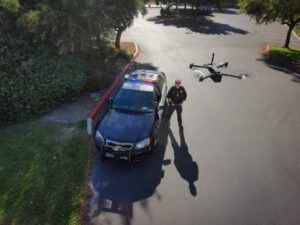
News and Commentary. In San Francisco, Prop E will be on the ballot on March 5. Among other provisions designed to help public safety agencies deal with rising crime rates in the city, Prop E would ease the way for police drone use. The discussion in San Francisco’s media, however, has highlighted the drone industry’s imperative to educate community leaders and lawmakers about what drones are good at – the de-escalation and better outcomes that most communities hope for.
Prop E is supported by Mayor London Breed. It has a number of provisions, including reducing the reporting requirements and allowing the use of body camera footage as a reporting mechanism and the reduction of administrative tasks to no more than 20% of an officer’s time. Prop E also calls for a technology policy that would allow the San Francisco police force to use drones. Interestingly, the focus of both Prop E and the media push surrounding it has been based on the use of drones in high speed vehicle chases: but the proposal opens the door for additional uses of drone technology.
The opposition from the ACLU and media comments about Prop E, however, highlight the need for further education of community leaders and activists. An article in Cal Matters conflates drones with “surveillance technology,” a common thread that misunderstands the purpose and the standards of drone use in most public safety departments.
Having covered the drone industry for almost a decade, I’ve had many conversations about police drone use. I’ve had to explain to well-meaning people that the drones in question are in no way weaponized; that they provide situational awareness, not surveillance; and that there are strict federal laws governing the use of drones. I tell often the paradigm-shifting conversation I once had with an officer from South Carolina who explained that they always put a drone up before entering the home of suspect in a SWAT operation. When I asked what they looked for, he had one simple answer: toys. They used drones to ensure that they were aware of any possibility that children would be present, so that they could ensure the appropach was appropriate.
These are conversations that we all need to have, to ensure that public safety officers in cities like San Francisco – already faced with multiple challenges – have the tools they need to make their jobs easier, to ensure the safety of their officers and the community. Drones are not “surveillance technology.” They are “de-escalation technology” that ensure that all parties have the information they need to enter a situation safely and calmly; to know in advance whether the suspect is holding a weapon or a water gun; and to protect surrounding communities.
Read more:
- ACLU Calls for Strict Limits on Police Drones. Skyfire Consulting Asked Them Why.
- Fremont, CA, Pioneers Joint Drone First Responder Program for Fire and Police Departments
- Drone as First Responder, with Airspace Awareness: Flying Lion and Iris Automation Partner

Miriam McNabb is the Editor-in-Chief of DRONELIFE and CEO of JobForDrones, a professional drone services marketplace, and a fascinated observer of the emerging drone industry and the regulatory environment for drones. Miriam has penned over 3,000 articles focused on the commercial drone space and is an international speaker and recognized figure in the industry. Miriam has a degree from the University of Chicago and over 20 years of experience in high tech sales and marketing for new technologies.
For drone industry consulting or writing, Email Miriam.
TWITTER:@spaldingbarker
Subscribe to DroneLife here.